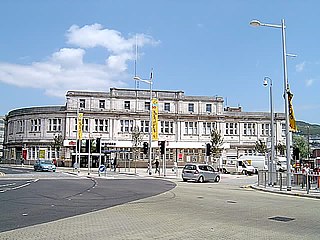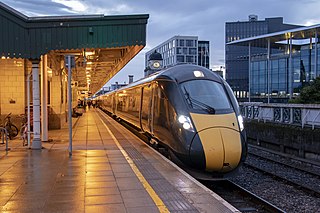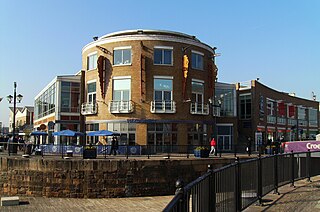
Swansea is a coastal city and the second-largest city of Wales. It forms a principal area, officially known as the City and County of Swansea.

The Powerhouse Museum, formerly known as the Museum of Applied Arts & Sciences (MAAS), is a collection of museums in Sydney, and owned by the Government of New South Wales. Its main centre is in Ultimo, New South Wales, the others being the historic Sydney Observatory at Observatory Hill, and the newer Powerhouse Castle Hill at Castle Hill. Powerhouse Parramatta is due to open in 2025.

The Swansea and Mumbles Railway was the venue for the world's first passenger horsecar railway service, located in Swansea, Wales, United Kingdom.
The history of Swansea covers a period of continuous occupation stretching back a thousand years, while there is archaeological evidence of prehistoric human occupation of the surrounding area for thousands of years before that.

Swansea railway station serves the city of Swansea, Wales. It is 216 miles 7 chains (348 km) measured from London Paddington on the National Rail network.

Landore is the name of an electoral ward in the City and County of Swansea, Wales, UK.
Swansea city centre in Swansea, Wales, contains the main shopping, leisure and nightlife district in Swansea. The city centre covers much of the Castle ward including the area around Oxford Street, Castle Square, and the Quadrant Shopping Centre; Alexandra Road, High Street, Wind Street and the Castle; Parc Tawe; and the Maritime Quarter extending down to the seafront.

Transport in Wales is heavily influenced by the country's geography. Wales is predominantly hilly or mountainous, and the main settlements lie on the coasts of north and south Wales, while mid Wales and west Wales are lightly populated. The main transport corridors are east–west routes, many continuing eastwards into England.

The Landore viaduct is a railway viaduct over the Swansea valley and the River Tawe at Landore in south Wales. It provides a link between Swansea city center and the West Wales Line to the South Wales Main Line. The valley crossing provides a panoramic view of Landore, Kilvey Hill, the Liberty Stadium and the Swansea Enterprise Park.
Hafod is a district of the city of Swansea, Wales, and lies just north of the city centre, within the Landore ward. Hafod is the home to the Hafod Copperworks, founded in 1810 and closed in 1980 which is now being developed into an industrial heritage site.

Mermaid Quay is a waterfront shopping and leisure district in the Cardiff Bay area of Cardiff, Wales. The 14,000 m2 (150,000 sq ft) development was opened in 1999, and includes restaurants, bars, cafes and shops.

The Royal Institution of South Wales is a Welsh learned society founded by George Grant Francis in Swansea in 1835.

Landore is a district and community in Swansea, Wales. The district falls in the Landore council ward. A mainly residential area, it is located about 2.5 miles north of Swansea city centre. The north-easterly part of Landore is known as Morfa. There have been a number of new developments in the 21st century, such as the Liberty Stadium, now the Swansea.com Stadium, and the Morfa Shopping Park, which opened in 2005. It had a population of 6,168 as of the 2011 UK census.
The Swansea Improvements and Tramway Company operated street trams in and around Swansea in Wales from 1878 to 1937.

The Riverside Museum is a museum in the Yorkhill area of Glasgow, Scotland, housed in a building designed by Zaha Hadid Architects, with its River Clyde frontage at the new Pointhouse Quay. It forms part of the Glasgow Harbour regeneration project. The building opened in June 2011, winning the 2013 European Museum of the Year Award. It houses many exhibits of national and international importance. The Govan–Partick Bridge, which will provide a pedestrian and cycle path link from the museum across the Clyde to Govan, is set to be completed in 2024.

The remains of the Hafod-Morfa Copperworks, originally developed by Vivian & Sons, consists of a core Grade II listed building and additional Grade II listed structures on a 12 acres (4.9 ha) site, on the banks of the River Tawe in Hafod, Swansea.

Tramshed is a music and arts venue in Cardiff, Wales, located in a Grade II-listed building that was once the old tram depot for west Cardiff. The newly redeveloped venue opened to the public in October 2015. It has a 1,000 capacity, however this is only reached up to six occasions per annum.
Tramsheds may refer to a tram depot. It may also refer to:














